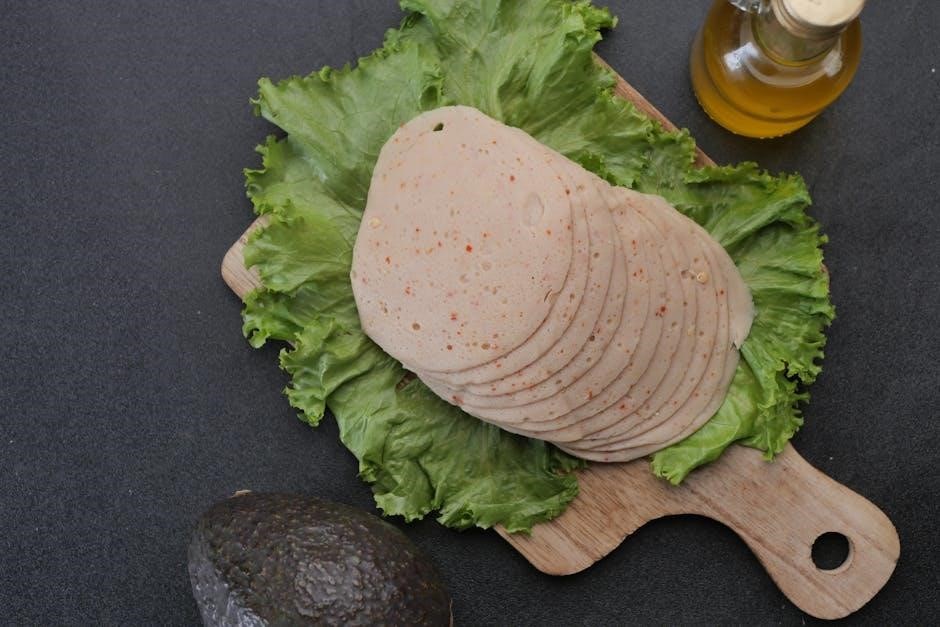The GAPS Diet focuses on healing digestive issues through nutrient-dense foods‚ eliminating harmful substances‚ and promoting gut health. It offers structured meal plans for optimal recovery and wellness.
1.1 What is the GAPS Diet?
1.2 Benefits of the GAPS Diet
The GAPS Diet offers numerous health benefits‚ primarily targeting gut healing and reducing inflammation. It helps alleviate digestive issues like bloating and Irritable Bowel Syndrome. By focusing on nutrient-dense foods‚ the diet enhances nutrient absorption‚ boosting energy levels and immune function. Many followers report improved mental clarity and reduced symptoms of neurological conditions. The diet’s structured approach simplifies meal planning‚ making it easier to adhere to long-term. Overall‚ the GAPS Diet is a holistic approach to wellness‚ promoting healing from the inside out and supporting overall health through balanced nutrition and gut restoration.

Core Principles of the GAPS Diet
The GAPS Diet emphasizes nutrient-dense foods‚ eliminates harmful substances‚ and focuses on gut healing through a structured introduction diet‚ promoting long-term digestive and overall health.
2.1 Focus on Nutrient-Dense Foods
The GAPS Diet prioritizes nutrient-dense foods to support gut healing and overall health. Emphasis is placed on high-quality meats‚ fish‚ and vegetables‚ as well as bone broth and meat stock‚ which are rich in essential nutrients and collagen. Healthy fats‚ such as avocado and olive oil‚ are encouraged to provide sustained energy and support digestion. Fermented foods‚ like sauerkraut and yogurt‚ are included for their probiotic benefits‚ promoting a balanced gut microbiome. The diet avoids processed foods‚ grains‚ and refined sugars‚ focusing instead on whole‚ organic‚ and seasonal ingredients to maximize nutritional intake and minimize inflammation.
2.2 Elimination of Harmful Foods
The GAPS Diet emphasizes the removal of harmful foods that disrupt gut health and contribute to inflammation. These include grains‚ processed foods‚ refined sugars‚ and unhealthy fats‚ which can damage the digestive system and impair nutrient absorption. Additionally‚ the diet advises avoiding high-starch vegetables‚ legumes‚ and foods high in phytates‚ lectins‚ or oxalates‚ as they can hinder healing. By eliminating these substances‚ the diet aims to reduce inflammation‚ promote gut repair‚ and support the body’s natural detoxification processes. This foundational step is crucial for creating an environment where healing can begin and for addressing underlying digestive and neurological challenges effectively.

Understanding the GAPS Diet Meal Plan
The GAPS Diet meal plan emphasizes nutrient-dense foods‚ bone broth‚ and gradual introduction of foods to promote gut healing and overall well-being while avoiding harmful substances.
3.1 Overview of the Full GAPS Diet
The full GAPS Diet focuses on nutrient-dense‚ easily digestible foods to promote gut healing and nutrient absorption. It includes meat‚ fish‚ shellfish‚ vegetables‚ fermented foods‚ and bone broth. Meals are structured to avoid harmful substances like processed foods and sugars. The diet emphasizes the importance of starting with meat stock or bone broth at breakfast‚ followed by a variety of allowed foods. Gradually introducing new foods ensures the gut lining heals properly. Olive oil is incorporated gradually‚ starting with small amounts and increasing to 1-2 tablespoons per meal. Fermented foods are also introduced to support gut health and immune function. This structured approach aims to restore digestive and overall well-being by focusing on whole‚ nutrient-rich foods.
3.2 Allowed Foods on the GAPS Diet
The GAPS Diet emphasizes whole‚ nutrient-dense foods to support gut healing. Allowed foods include meats‚ fish‚ shellfish‚ eggs‚ and a variety of vegetables‚ both cooked and raw. Fermented foods‚ such as sauerkraut and yogurt‚ are encouraged to promote gut health. Bone broth and meat stock are staples‚ providing essential nutrients for healing. Healthy fats like avocado‚ olive oil‚ and ghee are also permitted. Fresh fruits‚ nuts‚ and seeds are included in moderation. The diet avoids processed foods‚ grains‚ and sugars‚ focusing on naturally occurring vitamins and minerals. This approach ensures the body receives the nutrients needed for optimal digestion and overall well-being.
3.3 Sample Breakfast‚ Lunch‚ and Dinner Ideas
Breakfast options on the GAPS Diet often include bone broth‚ meat stock‚ or a GAPS milkshake. Homemade pancakes or muffins made from almond flour are popular choices. Lunch and dinner ideas focus on meats‚ fish‚ or shellfish paired with vegetables‚ either raw‚ cooked‚ or fermented. Soups and stews are staples‚ often served with a side of sauerkraut or avocado. Cold-pressed olive oil and lemon juice can be used as dressings for salads. Fermented foods like yogurt or kefir are also incorporated to support gut health. These meals are designed to be nutrient-dense and easy to digest‚ promoting healing and overall well-being.
3.4 Incorporating Bone Broth and Meat Stock
Bone broth and meat stock are cornerstone components of the GAPS Diet‚ rich in collagen‚ amino acids‚ and minerals. They support gut healing by repairing the gut lining and reducing inflammation. Typically consumed at breakfast and throughout the day‚ these stocks are made from slow-cooked animal bones and vegetables. They are easy to digest‚ making them ideal for those with sensitive stomachs. Many followers start their day with a warm cup of broth to stimulate digestion and provide essential nutrients. Regular consumption aids in improving nutrient absorption and overall digestive health‚ which are critical for the diet’s success and healing process.
4.2 Foods to Introduce Gradually

Common GAPS Diet Recipes
The GAPS Diet features recipes rich in nutrient-dense foods‚ emphasizing bone broth‚ meat‚ fish‚ and vegetables. Meals are simple‚ healing-focused‚ and designed to promote gut health naturally.
5.1 Breakfast Recipes
GAPS breakfast recipes emphasize nutrient-dense foods to support gut healing. Common options include scrambled eggs with vegetables‚ GAPS-friendly pancakes made with almond flour‚ and muffins using coconut flour. Bone broth is often consumed first thing in the morning to nourish the digestive system. Many recipes incorporate fermented foods‚ such as sauerkraut or yogurt‚ to promote gut health. Smoothies made with ripe bananas‚ avocados‚ and fresh berries are also popular‚ as they are gentle on the digestive system. These breakfast ideas are designed to be simple‚ flavorful‚ and aligned with the GAPS Diet principles‚ avoiding grains and processed sugars while focusing on whole‚ healing foods.
5.2 Soup and Stew Recipes
Soups and stews are cornerstone dishes in the GAPS Diet‚ offering nourishment and ease of digestion. Bone broth serves as a foundational ingredient‚ rich in collagen and minerals. Popular recipes include chicken or beef stew with vegetables like carrots‚ celery‚ and zucchini. Butternut squash soup and creamy broccoli soup are also favorites‚ often enhanced with garlic and herbs. These dishes are designed to be gentle on the gut while providing essential nutrients. Fermented vegetables like sauerkraut can be added for extra probiotic benefits. Soups and stews are versatile‚ allowing for customization with seasonal produce and proteins‚ making them a staple in the GAPS meal plan.
5.3 Main Course Ideas
Main courses on the GAPS Diet emphasize whole‚ nutrient-dense foods‚ ensuring balanced nutrition. Grilled meats like beef‚ chicken‚ and fish are staples‚ often served with roasted or sautéed vegetables. Baked salmon with asparagus and avocado oil is a popular choice‚ while ground beef patties with zucchini and mushrooms offer variety. Vegetables like broccoli‚ cauliflower‚ and spinach are commonly featured‚ often fermented for added probiotic benefits. Meals are seasoned with herbs and sea salt‚ avoiding processed additives. These dishes are designed to be flavorful and satisfying‚ supporting gut healing and overall well-being while adhering to the diet’s principles.

Tips for Following the GAPS Diet
- Plan meals in advance to avoid last-minute unhealthy choices.
- Gradually introduce new foods to monitor tolerance.
- Incorporate bone broth daily for gut healing.
- Start with small amounts of olive oil and increase gradually.
6.1 How to Stay Compliant Long-Term

Staying compliant with the GAPS diet requires consistent planning and commitment. Start by creating a weekly meal plan to avoid impulsive decisions. Track your progress through a journal to monitor improvements and setbacks; Gradually introduce new foods to ensure tolerance and minimize digestive discomfort. Incorporate bone broth and fermented foods daily for sustained gut health; Begin with small amounts of olive oil and gradually increase intake. Set realistic goals and celebrate small achievements to maintain motivation. Consistency is key‚ so stick to the diet even during social gatherings or special events. Over time‚ these habits will become a natural part of your lifestyle.
6.2 Managing Social and Family Challenges

Following the GAPS diet can present social and family challenges‚ but with proper strategies‚ these can be managed effectively. Communication is key—explain the diet’s benefits to loved ones to gain their support. When dining out‚ opt for GAPS-friendly options like grilled meats or salads with olive oil and lemon. Bring your own meals to gatherings to avoid temptation. Involve family in meal preparation to foster a sense of teamwork. Educate others about the diet to reduce misunderstandings. Stay patient and celebrate small victories to maintain motivation. Remember‚ the long-term health benefits outweigh temporary social inconveniences.
6.3 Tracking Progress and Adjustments
Regularly tracking progress on the GAPS diet is essential for long-term success. Keep a journal to monitor digestive changes‚ energy levels‚ and overall well-being. Note any improvements or setbacks to identify patterns. Adjustments may include introducing new foods gradually or increasing olive oil intake. Celebrate small victories to stay motivated. If symptoms persist‚ consider consulting a healthcare professional. Be patient‚ as healing takes time. Continuous monitoring ensures the diet remains effective and tailored to individual needs‚ fostering a healthier gut and improved quality of life.

Scientific Evidence and Testimonials
The GAPS diet is supported by studies on gut health and nutrition. Testimonials from followers highlighting improved digestion‚ reduced inflammation‚ and enhanced overall well-being.
7.1 Research Supporting the GAPS Diet
Research highlights the GAPS diet’s effectiveness in addressing gut health and neurological conditions. Studies demonstrate its ability to restore gut microbiota balance‚ reduce inflammation‚ and improve nutrient absorption. The diet’s focus on nutrient-dense foods and elimination of harmful substances aligns with scientific principles of digestive healing. Clinical trials and case studies show significant improvements in symptoms associated with autism‚ ADHD‚ and chronic digestive disorders. The structured meal plans‚ including bone broth and fermented foods‚ are backed by evidence supporting their therapeutic benefits. Testimonials from followers further validate the diet’s success in promoting long-term health and wellness.
7.2 Success Stories from GAPS Diet Followers
Many individuals have reported significant improvements in digestive health and overall well-being after following the GAPS diet. Testimonials highlight reductions in inflammation‚ enhanced nutrient absorption‚ and relief from chronic conditions like autism and ADHD. Followers often praise the diet’s structured approach‚ emphasizing the importance of bone broth‚ fermented foods‚ and gradual introduction of new foods. Improved energy levels‚ clearer skin‚ and better mental clarity are commonly noted. The diet’s focus on healing the gut has empowered many to achieve long-term wellness‚ making it a transformative choice for those seeking holistic health solutions. These success stories underscore the GAPS diet’s potential for profound positive change.

14-Day GAPS Diet Schedule
A structured 14-day plan outlining daily meals‚ including bone broth‚ vegetables‚ and proteins. Gradually incorporate olive oil and fermented foods to support gut healing and detoxification naturally.
8.1 Day-by-Day Meal Plan Overview
The 14-day GAPS meal plan provides a detailed schedule‚ ensuring each day includes nutrient-rich foods. Breakfast often starts with bone broth and a GAPS milkshake‚ followed by meals featuring meat‚ fish‚ and vegetables. Lunch and dinner ideas emphasize raw‚ cooked‚ or fermented vegetables‚ paired with proteins like meat or shellfish. Olive oil is introduced gradually‚ increasing from a few drops to 1-2 tablespoons per meal. Fermented foods are incorporated to enhance gut health. Each day builds on the previous‚ promoting healing and reducing digestive discomfort through carefully selected‚ easy-to-digest meals.
8.2 Incorporating Fermented Foods
Fermented foods play a crucial role in the GAPS diet‚ enhancing gut health and digestion. They are introduced gradually‚ starting with small amounts to avoid discomfort. Sauerkraut‚ kimchi‚ and kefir are common choices‚ rich in probiotics. These foods support the healing of the gut lining‚ boosting immune function and nutrient absorption. Regular consumption helps restore beneficial bacteria‚ essential for overall well-being. Fermented vegetables and dairy products are encouraged‚ offering diverse flavors and nutritional benefits. Over time‚ they become a staple‚ aiding in long-term digestive health and promoting a balanced gut microbiome.
8.3 Increasing Olive Oil Intake
Incorporating olive oil into the GAPS diet is essential for improving digestion and reducing inflammation. Start with a few drops per meal‚ gradually increasing to 1-2 tablespoons. Cold-pressed olive oil is recommended for its purity and health benefits. It aids in healing the gut lining‚ enhancing nutrient absorption‚ and supporting overall well-being. Regular consumption helps balance the diet and promotes long-term health. Olive oil is a key component of the GAPS diet‚ supporting immune function and providing essential fatty acids for energy and vitality. Gradual increase ensures the body adapts without discomfort‚ making it a sustainable addition to daily meals.

The GAPS diet offers a transformative approach to healing through nutrition. By focusing on nutrient-dense foods and eliminating harmful substances‚ it promotes long-term health and well-being.
9.1 Final Thoughts on the GAPS Diet
The GAPS Diet is a holistic approach to healing‚ focusing on nutrient-dense foods and eliminating harmful substances. It addresses digestive and neurological issues‚ promoting long-term wellness. By following structured meal plans and gradually introducing foods‚ individuals can achieve significant health improvements. The diet emphasizes the importance of bone broth‚ fermented foods‚ and olive oil‚ while avoiding processed and toxic substances. Commitment to the GAPS Diet can lead to enhanced gut health‚ reduced inflammation‚ and overall well-being. It is a powerful tool for those seeking to restore their health naturally and sustainably.
9.2 Encouragement for Long-Term Commitment
Embracing the GAPS Diet long-term requires dedication‚ but the rewards are profound. By focusing on nutrient-dense foods and avoiding harmful substances‚ individuals can achieve lasting gut health and overall wellness. The structured meal plans and gradual introduction of foods make the journey manageable. Incorporating bone broth‚ fermented foods‚ and olive oil becomes second nature‚ while avoiding processed items fosters a healthier lifestyle. Testimonials from followers highlight significant improvements in digestion and energy levels. Staying committed to the GAPS Diet can lead to a life free from chronic issues‚ offering a sustainable path to healing and vitality for years to come.
